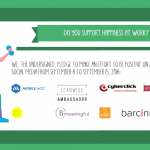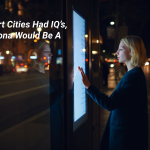Looking over the square of Placa Catalunya, CAPSiDE is innovating the digital society. Not alone, but with everyone that shares their vision. On Wednesday, they held their first Capside Open Day telling the story of their evolution and how to nurture creativity & innovation across the organization.

Capside Open Day
On the third floor above the FNAC center, you enter the Capside premises, a bright, open office with each meeting room labeled with an IT twist, “/lib”, “/tmp” or “/home” to name a few, introducing architects to the world of digital. This is where 25 young and enthusiastic employers combine different technologies and online services that interact in an efficient way. Capside protects the core digital services of their 350 worldwide clients. How? By having a 24/7 team available to tackle any problems their clients may face (see their movie). An interesting detail, the engineers are incentivized to achieve continuous improvement. For that reason they don’t get paid per fixed problem, rather per “uptime”, or the amount of time the system is online working without any problems. Therefore, if you weren’t able to buy the new F.C. Barcelona T-shirt you can’t blame the providers. They are able to cope with a huge amount of traffic; the bottleneck in this case is the physical stock. Capside is doing well. Since they opened their doors in 2001, Capside has seen a phenomenal annual growth rate of over 25%. The secret to staying on track and maintaining double digit annual growth, according to CEO Josep Ruano, is to always remain agile and have the flexibility to change. Capside employees are challenged to come up with innovative solutions, and they are motivated to do so. The company aims for a billable percentage of 70%, thereby dedicating 30% of their time to coming up with improvements to their standard processes and brainstorming new solutions to existing problems. To facilitate their innovation process the new office features plenty of whiteboard space, relaxing lounge chairs and will soon be opening their very own gym. However, the right physical space is not enough. Therefore, they invited Enric Segarra to speak to their team and invited guests about traveling down the bumpy road of innovation for which creativity is your only fuel.
Some ingredients to be creative:
- Recognizing that things should be done differently is not enough. The “abductive reasoning” approach is the “what-could-be-type” of thinking that is necessary to design the future.
- Creativity, the raw material of innovation, is often perceived as something dangerous, uncontrollable and risky, simply because creativity often intervenes with the daily business and forms an impediment to predictability and operational control. To avoid this, you need to create a culture where both daily progress and creative thinking can survive. Strive for ambidexterity to cope with the different capabilities of doers and organizational insiders. Balance order & routine with permissiveness.
- Creativity is an attitude, a way of life. When the stories in the office are about burn-out and stress, you know creativity won’t flourish. In these circumstances an escape is needed. A safe environment where curiosity is stimulated. Where people are happy to think out loud with the question: ‘what if…’. A company open to valuing these efforts will witness more enthusiasm, a willingness to learn, and an inherent need to explore new ideas.
- Creativity can’t be generated on demand. As a manager, you can’t simply say “¡Hagalo!” or “Just do it!” If you want to promote innovation, you must “walk the talk” and be careful of cynicism that can drag performance down. Instead, create space for autonomy, give room for mastery and self-deployment, and help your entire team see the larger purpose. A management style that emphasizes freedom, fairness, commitment and “waterline” decision making* is necessary to creating a culture that rewards risk taking. In summary, align your incentive system to achieve the innovation you want to see.

- Have a clear message, a message that every one is part of a larger effort, is making a difference, and creating value. No meaning = no happiness. No happiness = no creativity. No creativity = no innovation.
- Have a green sheep in your organization. Make sure everybody is not thinking from the same perspective. Use analogies to come up with other perspectives. A different background with another mindset may evoke the spurs for creativity. Stimulate intrapreneurship. Don’t forget that ideas are useless unless executed! But at the same time, be realistic. Not every idea will be a good one, but those that are have the potential to disrupt the way we live.
- Lastly, don’t leave your humor at home! A golden oldie: having fun can change behavior for the better, click here.
So keep an eye on this fast growing Barcelona-grown SME, which will feature more Open Day’s providing seminars starting this fall. It’s worth the visit.
—
*waterline principle
If you are on a ship and something happens that will blow a hole in the side of the hull, which would you prefer: Being above or below the waterline? If you blow a hole above the waterline (where you won’t sink), you can patch the hole and survive another day. However, if you blow a hole below the waterline, you can find yourself in serious trouble.
Implications:
1. What’s the upside, if events turn out well?
2. What’s the downside, if events go badly?
3. Can you live with the downside? Truly?
From: Jim Collins ‘How The Mighty Fall’ ; quoted statement from Bill Gore, founder of W.L. Gore & Associates







Leave a Reply